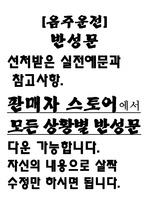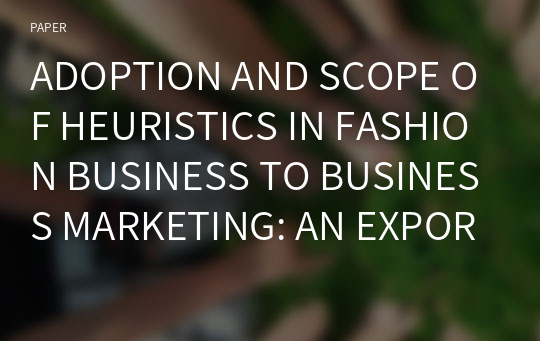ADOPTION AND SCOPE OF HEURISTICS IN FASHION BUSINESS TO BUSINESS MARKETING: AN EXPORATIVE CASE RESEARCH
* 본 문서는 배포용으로 복사 및 편집이 불가합니다.
서지정보
ㆍ발행기관 : 글로벌지식마케팅경영학회(GFMC)
ㆍ수록지정보 : GFMC Session1
ㆍ저자명 : Simone Guercini
ㆍ저자명 : Simone Guercini
영어 초록
This contribution focuses on fitting between heuristic rules and the task environment in business to business market. The subject is about evidence-based business decision-making process in the business actors‟ perspective. The empirical setting of fashion business to business markets is considered, focusing on adaptive behavior situated in the interaction processes in customer-supplier relationships emerging from empirical researches. The paper considers two key aspects of the process: (1) the origin and diffusion of the heuristic rules adopted by the actors (adoption) and (2) the fields in which the rules can be used (scope) are discussed. The central research questions are: How heuristics are adopted and diffused in the fashion business to business environment (adoption)? How wide is the context in which the heuristic rule is applied by the actors (scope)? Fashion business to business markets is our setting of analysis. First of all we have to define what are heuristics. Studies of decision-making processes generally divide them into two, mutually exclusive types: rational decision making versus rule-based decision making (March 1994). In the case of rational decision making the approach is to evaluate the consequences of any decision in terms of either pure (maximizing) or limited rationality (satisficing). In rational decision making, consequential choices are adopted, hence an evaluation of preferences and expectations is necessary and decisive to the final outcome. Instead, in rule-based decision making, what counts most is following the rules, the aim being to satisfy and/or define an identity. In rule-based decision making, rules deemed appropriate are adopted, and what then counts are the rules and the identity, which form the basis for taking well-thought-out actions. Rationality requires less „specific‟ knowledge, since it relies on abstract rules. In this approach, following the rules may instead involve understanding them in relation to the specific context in which they are to be applied. The relations between heuristics and interaction in business networks provide a means to study other aspects of the evolution of the relationship between enterprise and business market environment (Artinger et al. 2015; Guercini et al. 2014, 2015). In fact, the network of relationships the actors adopt images of the relationships to be cultivated with the precise aim of formulating an effective representation of the market, enable other phenomena to be examined, not so much in their qualitative aspects, but rather as regards their importance as perceived by business decision-makers. In light of these relations between heuristics and setting, the essential properties of heuristics that we propose to examine herein are: (1) specificity, intended as the field of application and setting in which any heuristic rule is generated and routinely applied; (2) convergence, which concerns how widespread, at least in appearance, any given heuristic rule is amongst actors in a given market setting (Guercini 2012). In other terms, the heuristics of entrepreneurial marketing can be considered specific to this particular setting, in that they concern the degrees to which such rules are generated, are successful, and are confined to the specific setting or context. Looking more closely at the two above-mentioned properties, specificity is high when, for instance, a heuristic refers to a specific, circumscribed matter (for example assessing the opportune moment to purchase certain semi-finished goods) and finds no application in any other setting. Conversely, a rule‟s degree of specificity is low when its field of application is broad: a rule may, since its inception, be applicable to many different fields, or it may be initially applicable only to a limited range of decisions, but subsequently find fruitful application in other, broader matters (Guercini et al. 2014). The degree of convergence instead regards the frequency with which a given heuristic rule is adopted within a population, a community or, in our case, by entrepreneurs. Such adoption may only be apparent, in the sense that what seems to be a single rule may actually represent various, subtly different rules for each individual, given the supremely personal, individual nature of fine mental processes. Evaluating the degree of convergence of a given heuristic within a population obviously involves measuring its dissemination in terms that are recognized as such by the researcher. Convergence is high for rules adopted by everyone, or at least by a large segment of the population in question. Other heuristic rules are instead developed by individuals in forming their personal judgments and seem to be unique to such individuals, in that they do not arise in others. This implies that heuristic rules may be the source of a relative advantage for the entrepreneur, in so far as the heuristic in question proves itself successful, that is, an element that determines a good choice when other methods are ineffective or may even produce negative effects. Specificity and convergence are thus general properties of the heuristics adopted by entrepreneurial marketers, and are strongly tied to the interpersonal relationships and consequent interactions within business decision-makers‟ personal contact networks (Guercini et al. 2015). Heuristic procedures are easily detectable in the descriptions of enterprise top management of the processes they utilize in assessing possibilities and forming judgments. Some of these procedures are highly abstract and applicable to various different settings, for instance, regarding problems typically facing firms as well as purchase decision-makers. In the following we shall briefly present some of the heuristics encountered in our research; a more detailed description and more rigorous modeling of their characteristics will be addressed in future work. Let us consider now a fashion business to business settings, and more precisely the situation in which the decision-maker of a fashion firm is tasked with formulating a judgment regarding the best choice of colors to keep up with the fashion trends of coming seasons. From interviews with representatives of styling divisions, what repeatedly emerged was their conviction that “strong” colors periodically and forcefully come back in fashion. Some even went so far as to specify the duration of this cycle: seven years – that is, the same as the number of strong colors –, which also turns out to be coherent with long-standing observations on the limits of human cognitive function (Miller 1956). No clearly defined explanation was offered of the reasons for, or origins of, this rule, although some hypotheses were advanced: simply that a sort of “law” was first noticed and then became consolidated as its predictions were repeatedly verified over time. A second example is that of the textile firm entrepreneurial marketer called on to provide a forecast of the fabrics that will be most widely utilized in the market over the next few seasons. From the marketer‟s perspective, the price of natural fibers is one element on which to base any judgment regarding future fabric usage trends. Clearly, there are technical time constraints on the purchasing of fibers for spinning, which must naturally precede the sale of the fabric, and may even take place already in the stage of drafting the fabric sample book. Thus, a specific assessment rule is applied: those fibers whose price increases during certain periods of the year are deemed to be those that will be in most widespread use the following season. However, for some years now this rule has begun to seem less reliable than in the past. Workers in the sector speak of greater complexity in the wool market, where supply factors, such as international manufacturers‟ policy of stepping up fiber tops production, have had the effect of upsetting traditional market dynamics. The heuristic rules in these examples can be regarded in the perspective of the attributes they present, in particular, their “specificity” (or field of application) and their “convergence” (or degree of dissemination). A rule that is highly specific to a certain application setting looses much of its value when applied to judgments other than the one for which it has been developed. On the other hand, a rule that is in widespread use in many firms can hardly become a distinctive resource for entrepreneurial marketers. The widespread dissemination of a given heuristic rule amongst the rules “in stock” or the “adaptive toolbox” of firms may influence its effectiveness. Indeed, the fact that a rule is shared by many may justify its adoption in light of the validity that the decision-makers seem to attribute it, even if it is less probable that its use impart a distinctive competitive advantage. The examples of heuristic processes presented in the foregoing seem to enjoy different degrees of specificity and convergence. The association of certain heuristics to specific settings takes on the significance attributed to them by Simon (1979), as rules bound by the task environment and not clearly referable to relatively abstract mechanisms or endowed with autonomy. Mechanisms applicable to less specific settings are instead referable to the heuristics described by Tversky and Kahneman (1974), including representativeness, availability and adjustment/anchoring, identified in relation to the possible distortions and errors associated to them. The heuristics modeled by “building blocks” by Gigerenzer et al. are seemingly cannot be captured by a few categories, given the variety of formal models identified. Briefly, these include (1) recognition heuristic; (2) fluency heuristic; (3) take-the-best; (4) tallying; (5) satisficing; (6) 1/N equality heuristic; (7) default heuristic; (8) tit-for-tat; (9) imitate the majority; (10) imitate the successful; (11) hiatus heuristic; (12) fast and frugal trees; (13) mapping models; (14) averaging the judgment; (15) social circle; (16) moral behavior (Gigerenzer and Gaissmaier 2011, Gigerenzer and Brighton 2009). In the approach proposed by Gigerenzer and his “adaptive behavior and cognition program”, formal models are necessary to evaluate the real contribution of heuristics to cognition, decision-making and behavior. For details, refer to the publications of the adaptive-behavior-and-cognition program (Gigerenzer 2007; Todd and Gigerenzer 2012). Rule-based decision making implies the availability of rules to follow and consistency with an established identity as the driving factors in the decisionmaking process. If the rules satisfy an ecological rationality approach, are such rules then the result of a process of rules selection with which the decision makers are endowed innately or they are formed through a process of learning? And, if the latter is true, what are the characteristics of the decision-making process during the stage that the rules formation schemes are more open? And lastly, when the rules have already been defined, are they necessarily stable or can they be questioned and, if so, in what terms? These research questions are part of the future research stimulated by this first exploration based on case study research.참고 자료
없음"GFMC Session1"의 다른 논문
 FAST AND SLOW FASHION BRANDS IN DEVELOPING SUSTAINABLE ..6페이지
FAST AND SLOW FASHION BRANDS IN DEVELOPING SUSTAINABLE ..6페이지 “WHAT IF A CELEBRITY AND A BRAND CO-CREATE A NEW COLLEC..7페이지
“WHAT IF A CELEBRITY AND A BRAND CO-CREATE A NEW COLLEC..7페이지 THE INSTAGRAM’S STRATEGY IN ENGAGING THE CUSTOMER’S LOY..3페이지
THE INSTAGRAM’S STRATEGY IN ENGAGING THE CUSTOMER’S LOY..3페이지 THE PARTICULARITIES OF NEW PRODUCT DEVELOPMENT IN THE T..5페이지
THE PARTICULARITIES OF NEW PRODUCT DEVELOPMENT IN THE T..5페이지 THE LONE CHOCOLATE BAR: THE INFLUENCE OF PERCEIVED SCAR..6페이지
THE LONE CHOCOLATE BAR: THE INFLUENCE OF PERCEIVED SCAR..6페이지 ADS AS WORKS OF ART: MEASURING ADVERTISING IMMERSION3페이지
ADS AS WORKS OF ART: MEASURING ADVERTISING IMMERSION3페이지 ECONOMIES OF SMALL: NICHE STRATEGIES AND SUCCESS FACTOR..8페이지
ECONOMIES OF SMALL: NICHE STRATEGIES AND SUCCESS FACTOR..8페이지 THE INFLUENCE OF ONLINE CUSTOMER REVIEWS ON RETAILERS' ..6페이지
THE INFLUENCE OF ONLINE CUSTOMER REVIEWS ON RETAILERS' ..6페이지 IS THE ARTIFICATION PROCESS PERCEIVED BY FINAL CONSUMER..6페이지
IS THE ARTIFICATION PROCESS PERCEIVED BY FINAL CONSUMER..6페이지 THE ODD EVEN PRICE PARADOX IN THE FASHION LUXURY SECTOR6페이지
THE ODD EVEN PRICE PARADOX IN THE FASHION LUXURY SECTOR6페이지


























